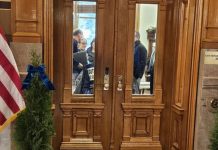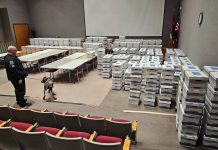Did you know about one-third of the food you ate this week likely is dependent on pollinators (bees, insects, birds and bats) to grow? This week is National Pollinator Week, and your chance to learn about the little creatures that have a big impact on your life.
The Indiana State Museum has two bee hives, both of which are cared for by Brian Benson, the museum’s facility engineering manager and (informally known as) chief beekeeper. To care for both bee hives, Brian monitors their health, taking corrective action when needed, makes sure they are able to make honey and beeswax, and harvests the honey when appropriate.
He also engages the community in conversations about bees, and set up a live video feed for people to dive inside the museum’s hives without ever having to put on a bee suit. Here, watch bees buzz into and out of their hive entrances, and see inside the hive as bees go about their daily work of making honey. See these live video feeds here, and read a Q&A with Brian below to get to know the man behind the bee mask.
What sparked your interest in bees?
“My interest in bees began when I noticed a swarm of bees land on a tree in front of my home about eight years ago. I thought it was Attack of the Killer Bees and had the kids stay inside! After doing some research, I learned that these bees were homeless and not aggressive – an hour later, they flew off.
“When the museum decided to host a bee hive about four years ago, I offered to help get it set up. This was my opportunity to learn about being a beekeeper.â€
Why is it important that the Indiana State Museum is the home of bee hives?
 Brian chats with Indiana State Museum summer campers about bees.
Brian chats with Indiana State Museum summer campers about bees.“Bees are incredibly important to native habitats. In their location on the balcony above the Watanabe Family Gardens, they help sustain a native Indiana wildflower garden. By spreading the word about people about how bees help sustain native habitats, the Indiana State Museum is able to be an active participant in preserving the present environment while protecting its future.â€
What are you doing for National Pollinator Week?
“I’ll be chatting with our summer campers telling them all about bees and answering their questions.
“I’ll also spend some extra time doing a health check on our two bee hives. One of them recently got a new queen, and I’ll make sure she gets off to a good start. I’ll continue providing some extra food for the other hive to help it continue building up its population.â€
What is your favorite thing about being the museum’s beekeeper?
“Any time I have the opportunity to be involved with something at the museum, that is exciting to me. To be able to help with something I also enjoy as a hobby – that’s even better.â€
What is your favorite thing about bees?
“Everything a bee does is for the survival of the hive. Every bee has a job, and some even graduate to new jobs when they get older. How the bees just know that and communicate with each other is fascinating.â€
What is the biggest challenge when it comes to taking care of bees?
 Brian shows summer campers a frame of live bees from the museum hive using a special observation box.
Brian shows summer campers a frame of live bees from the museum hive using a special observation box.“Bees often throw you curve balls, and it’s challenging making quick decisions when they do. The biggest challenge is making sure they are ready to survive the winter with enough food (honey) stored up, and enough bees to keep each other and the queen warm.â€
The Indiana State Museum and Historic Sites also has bee hives at two state historic sites, Gene Stratton-Porter State Historic Site and Angel Mounds State Historic Site. Bees are all around us helping our food grow and preserving our native habitats. Next time you see a bee, insect, bird or bat, don’t forget to say, “Thanks!â€




